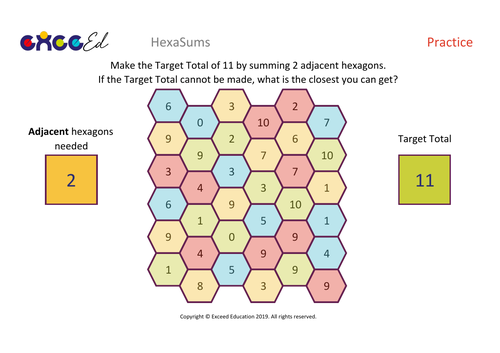
Do you operate a ‘mastery’ classroom? Do your students need to practise their addition skills to improve their fluency? Look no further than this HexaSums - Addition Fluency Starter.
How to use the Starters:
Each question starter displays a randomised set of 36 hexagons, each with a value attached. One the left of the screen, students are given an instruction to find a set number of adjacent hexagons, and sum their value to reach the Target Total (or as close to it as possible) on the right of the screen.
- The adjacent hexagons needed will always range between 2 and 6.
- The Target Total as always based on the mean average of all 36 hexagons, multiplied by the adjacent hexagons needed value. This means children will usually be able to find the Target Total exactly, but will always be very close at the very least.
Note: This is the free pack for addition. The full pack has a total of 8 PDF documents, each with 10 starter activities.
The full pack includes:
- All 36 hexagons between 0 and 10;
- All 36 hexagons between 0 and 20;
- All 36 hexagons between 0 and 50;
- All 36 hexagons between 0 and 100;
- 18 hexagons up to 10, and 18 hexagons up to 20;
- 18 hexagons up to 10, and 18 hexagons between 10 and 20;
- 18 hexagons up to 20, and 18 hexagons between 10 and 20;
- 18 hexagons up to 20, and 18 hexagons upto 100.
Embrace the power of small ‘Adjacent Hexagons Needed’ and 'Target Totals’
Try not to be tempted to skip the sessions with low numbers like 2 for the adjacent hexagons needed, and 11 for example for the Target Totals. You’ll be suprised how many different ways they will find to complete the task. This will also encourage that speed of recall (for example, in searching for number bonds to 11: 10 and 1, 9 and 2, 8 and 3 etc).
Encourage the children to make their own rules
Ok, so we all know they need to be fluent, and at times that requires speed. So what if you feel that they are already there? Encourage children to create their own rules. When we’ve led this with our children, they’ve come up with brilliant ways of adapting the game which still suit the aims of the teacher. Here are some of the best:
- Sir, can we use subtraction? Yes, of course.
For best results:
- Display the Question Starter on an IWB, or print for pairs of students;
- Use a 3-minute timer to allow children to find the target number;
- If children find an answer, encourage the mastery approach where they try to find other ways to achieve the Target Total;
- Make a game/competition from the Starter to create an ‘edge’ to the activity;
- Allow children to call out the answers in order afterwards as you mark as a whole class, discussing any difficulties or interesting patterns;
- Allow children to discuss their strategies for each question;
- Encourage discussion about number bonds and how they help.
The power of this daily approach is truly remarkable, and will have your children recognising number bonds to support calculation in no time.
Something went wrong, please try again later.
This resource hasn't been reviewed yet
To ensure quality for our reviews, only customers who have downloaded this resource can review it
Report this resourceto let us know if it violates our terms and conditions.
Our customer service team will review your report and will be in touch.
